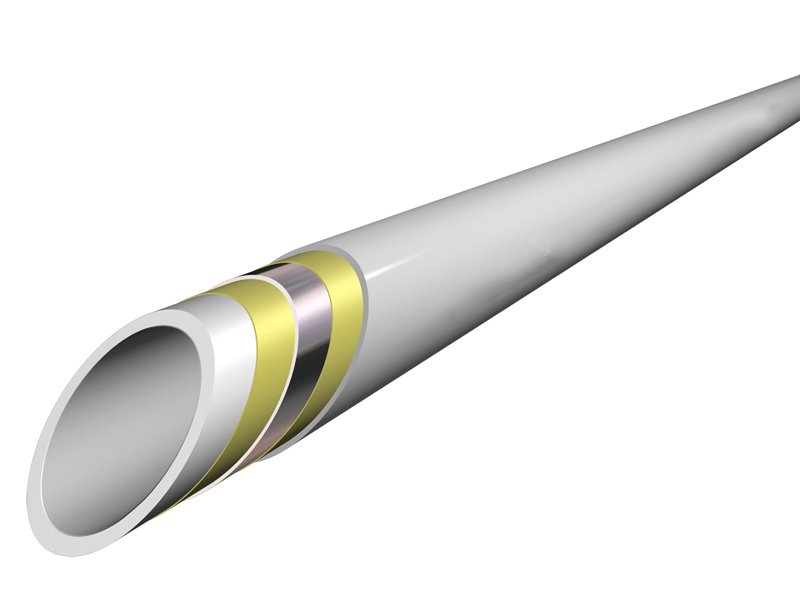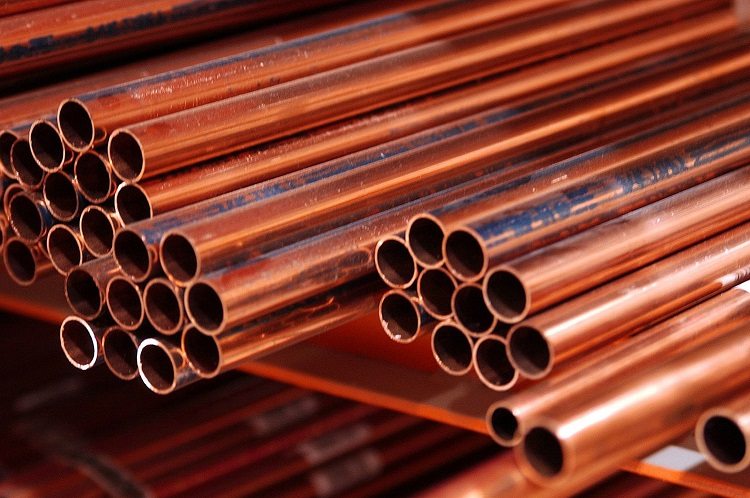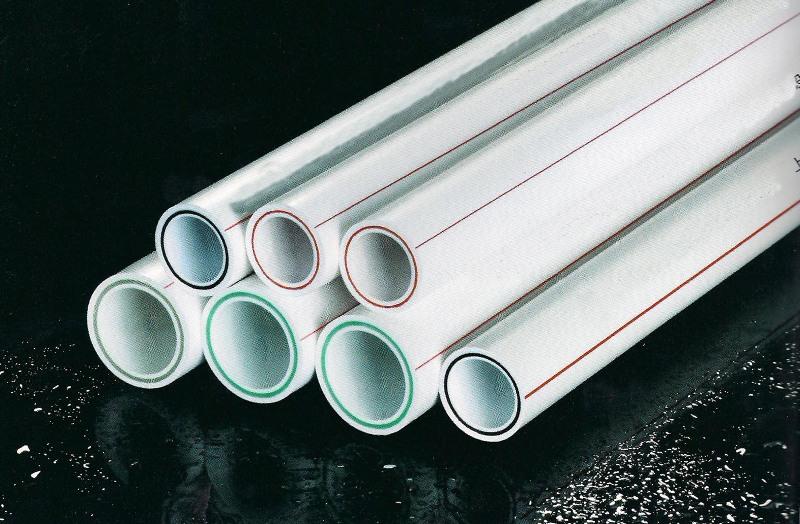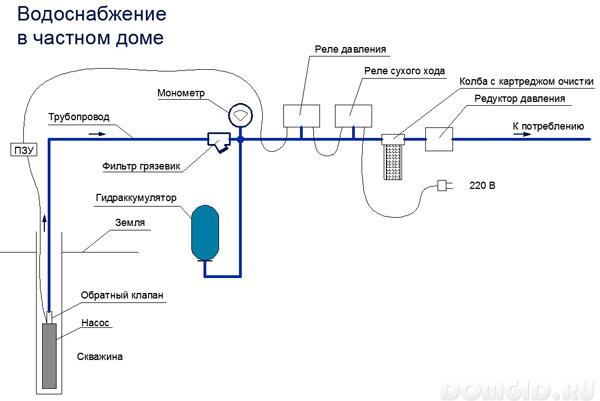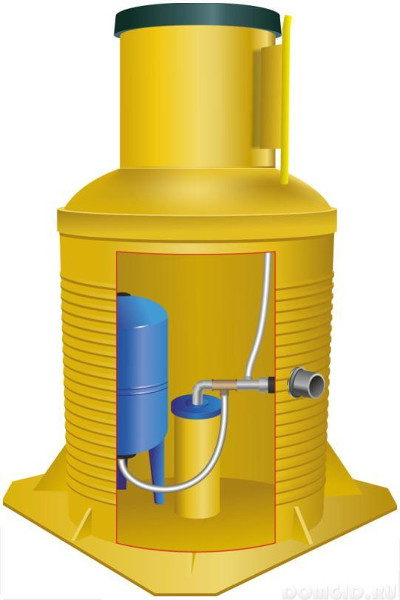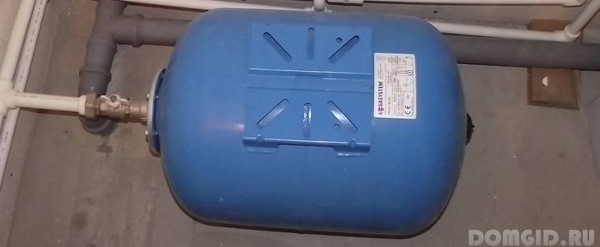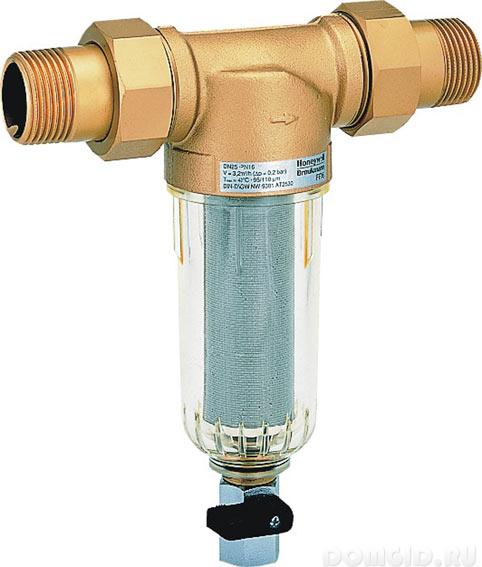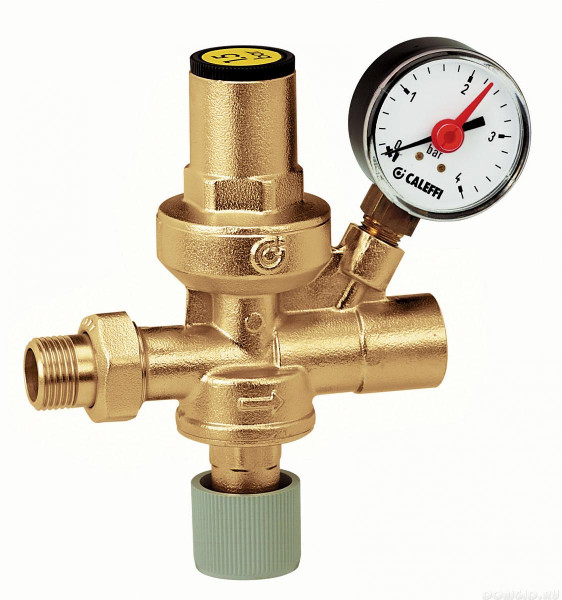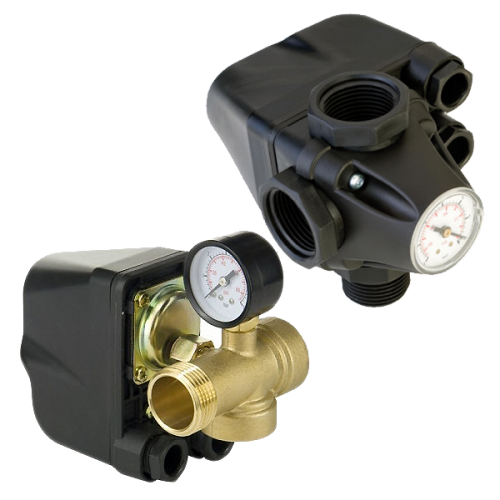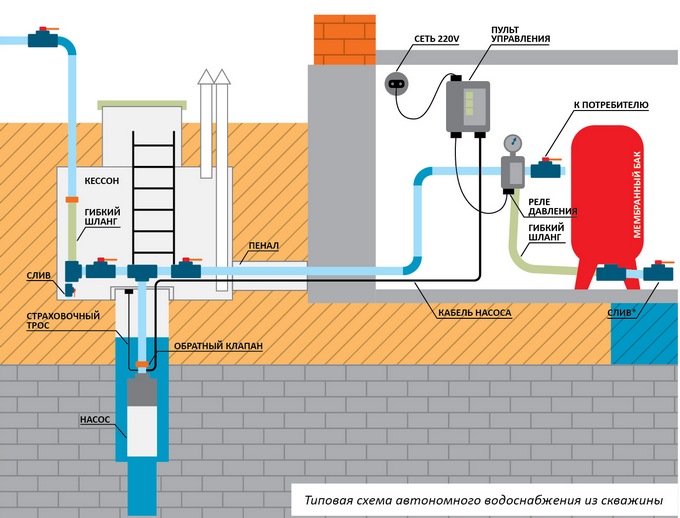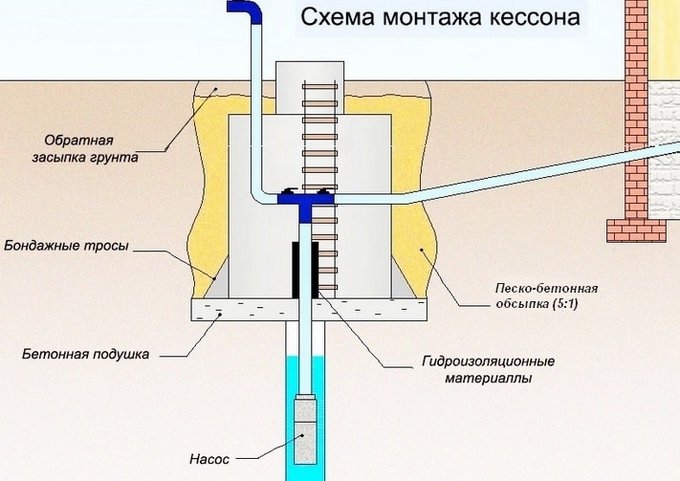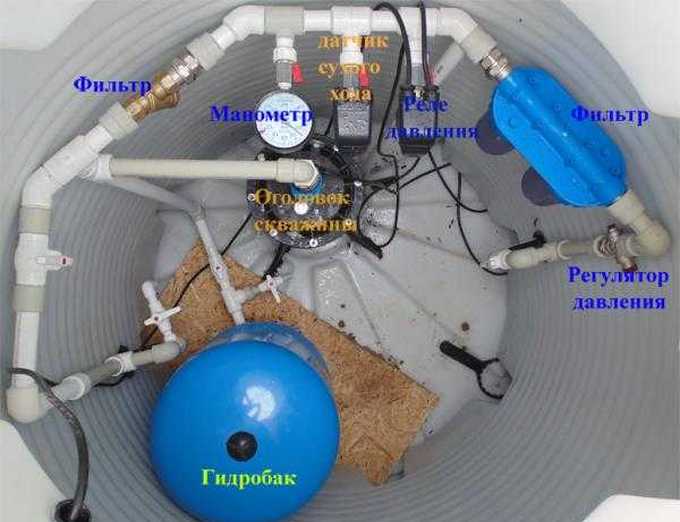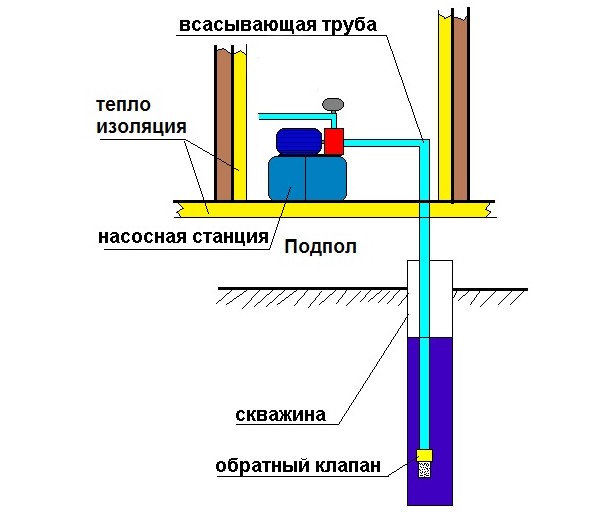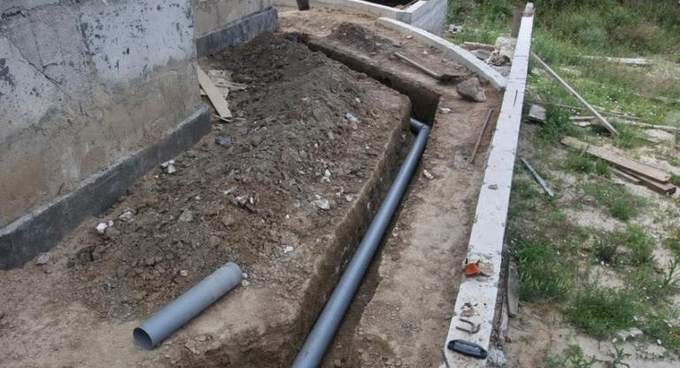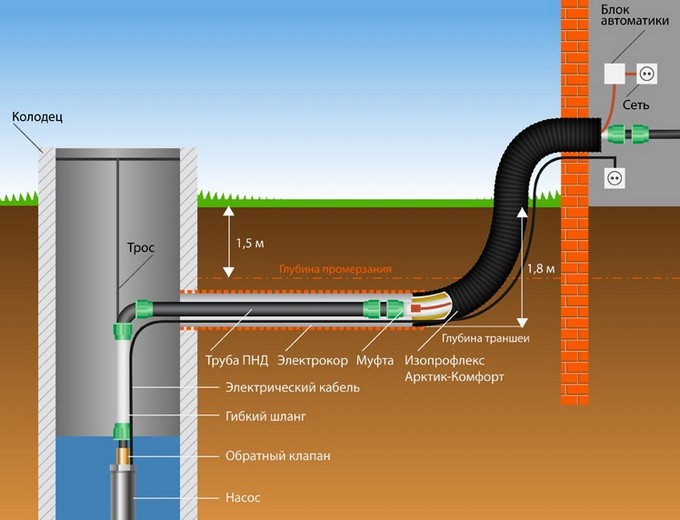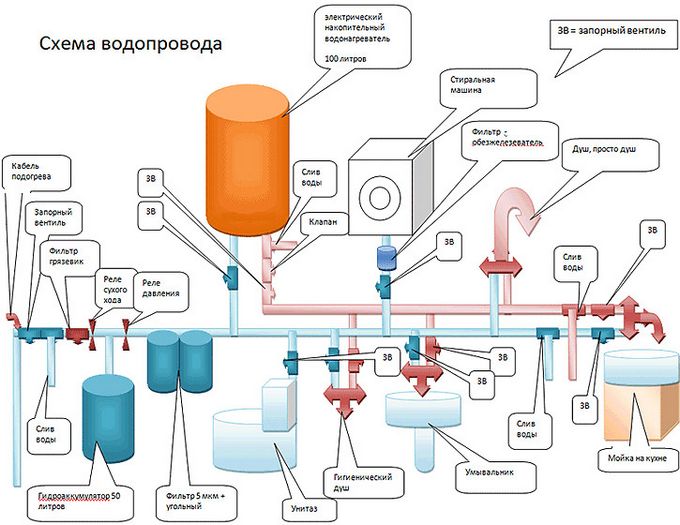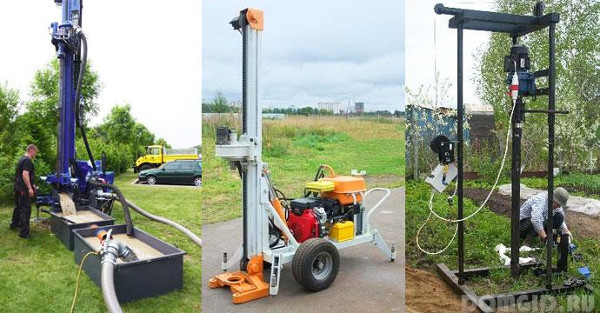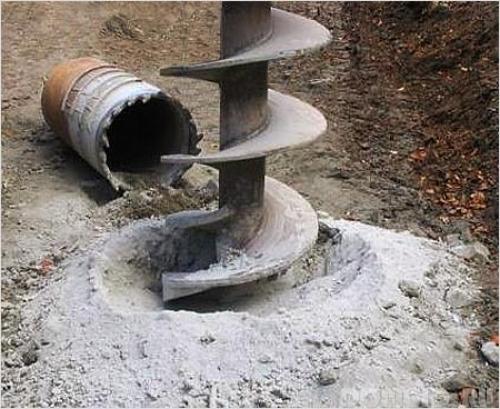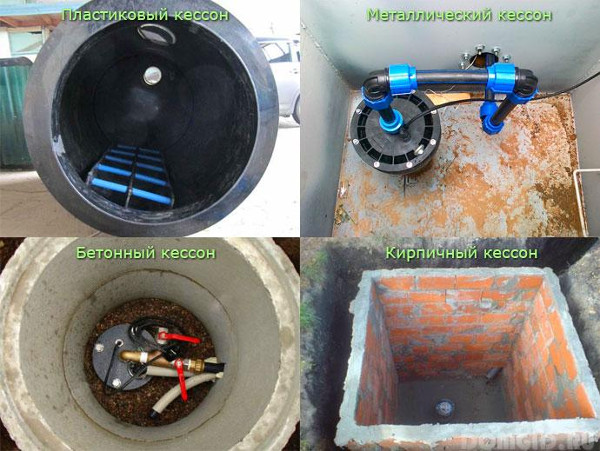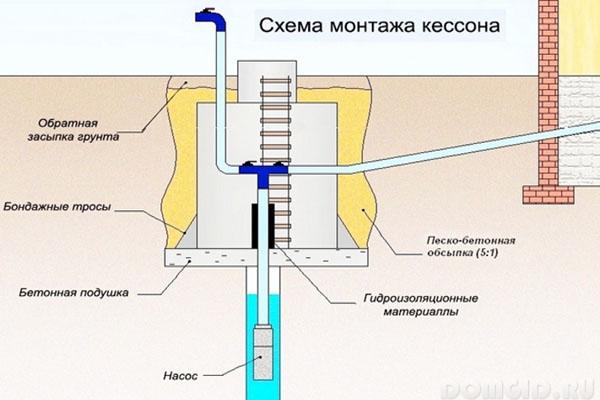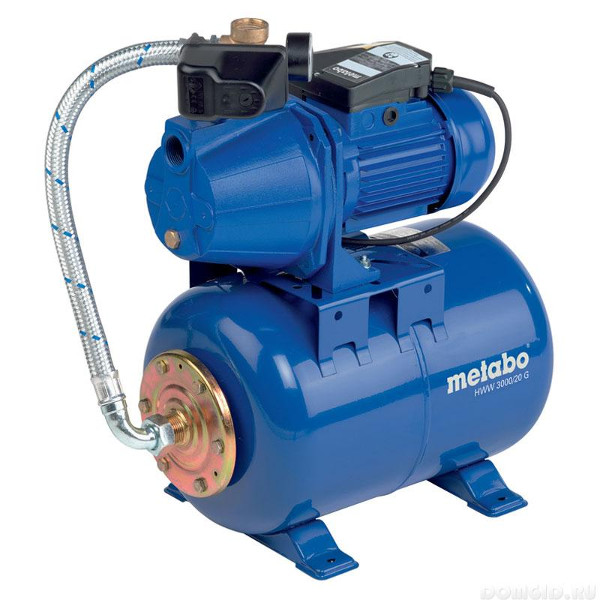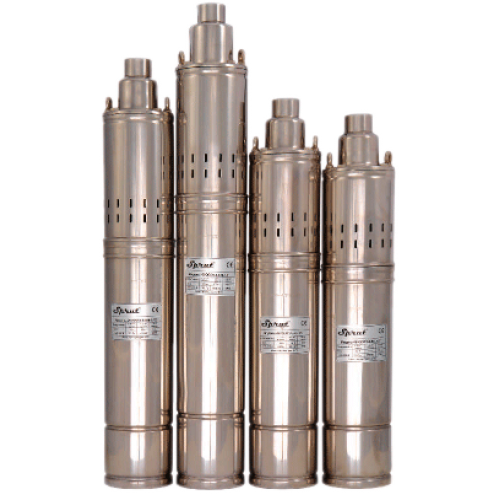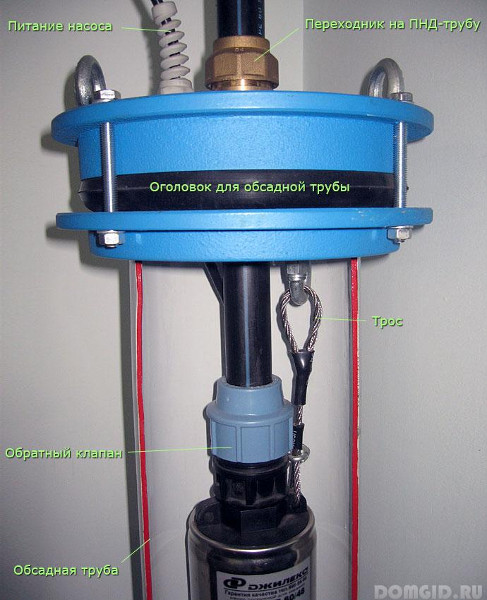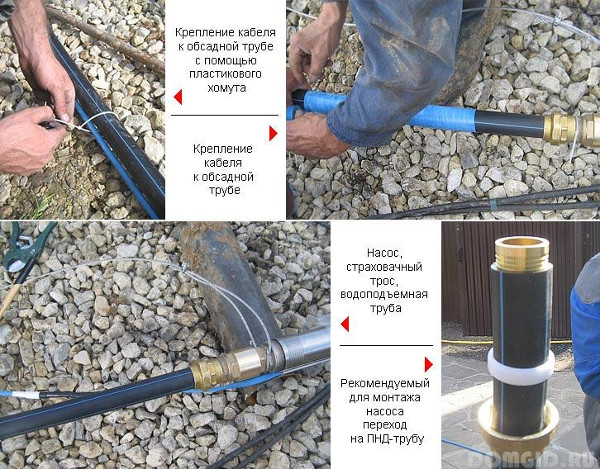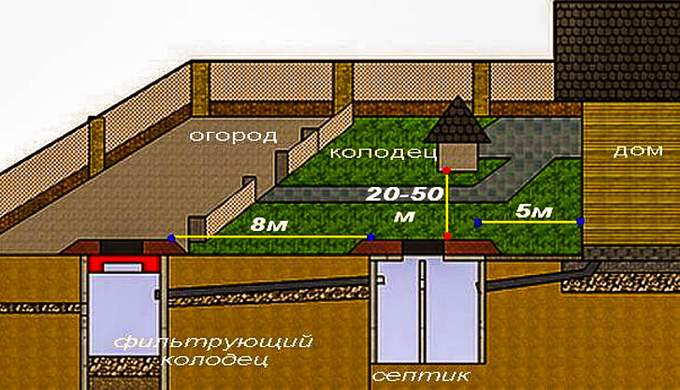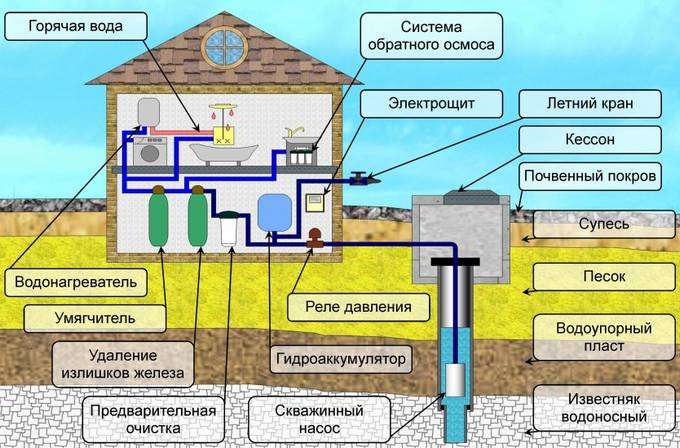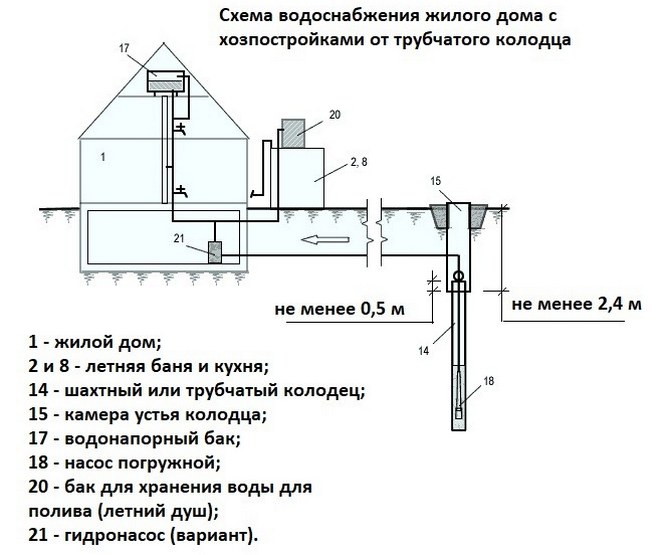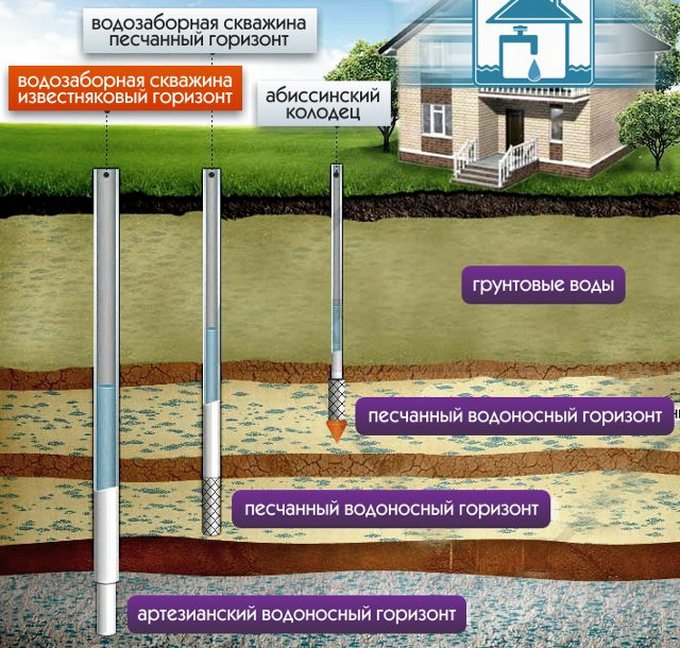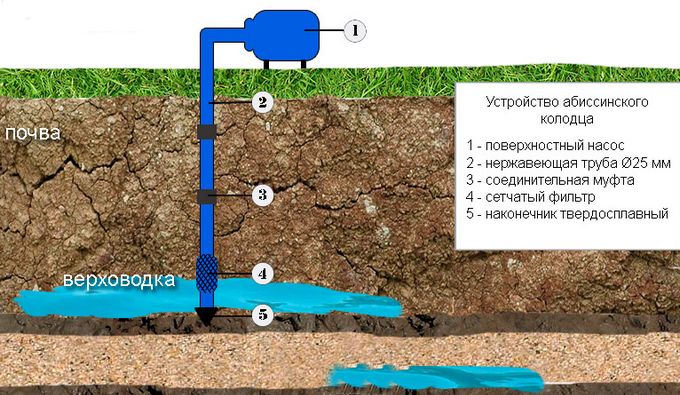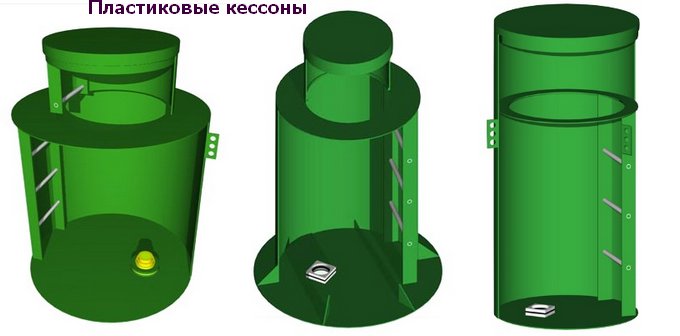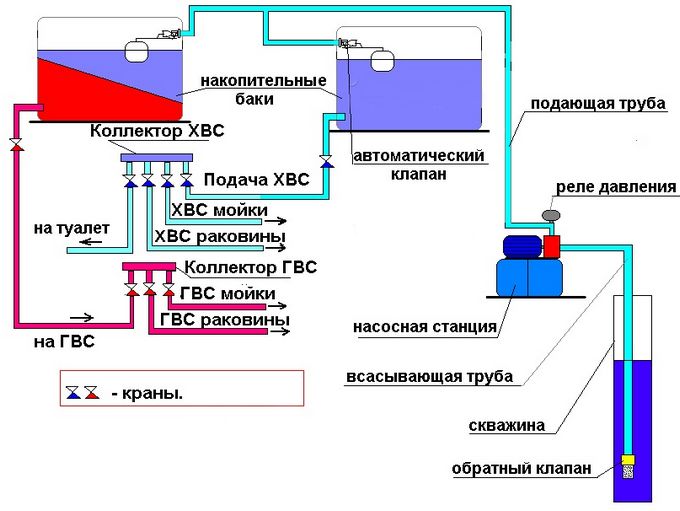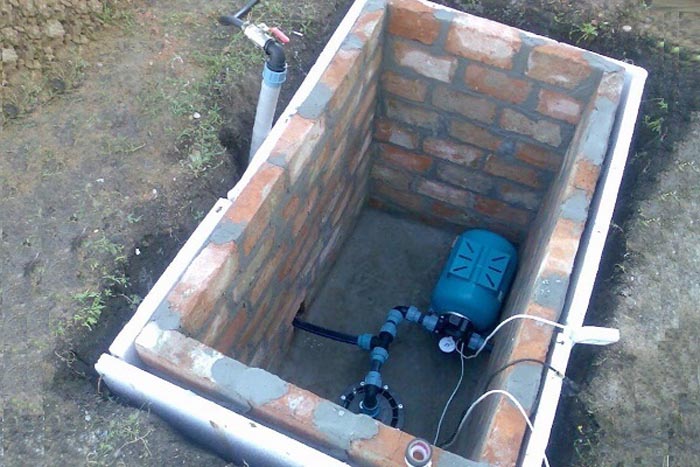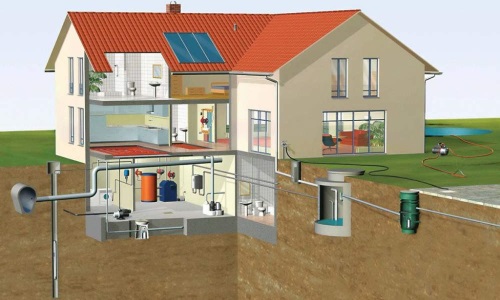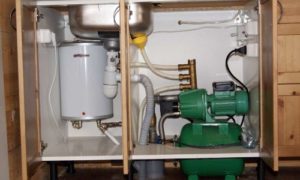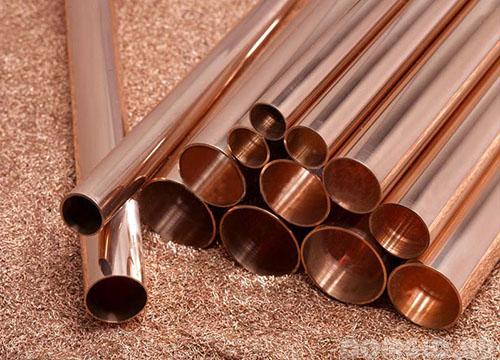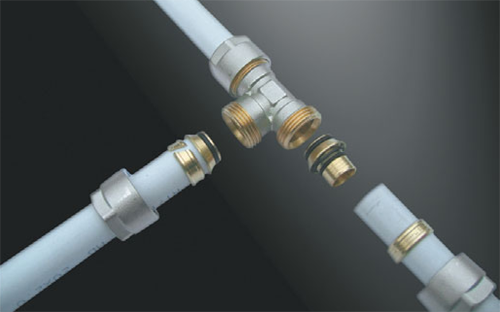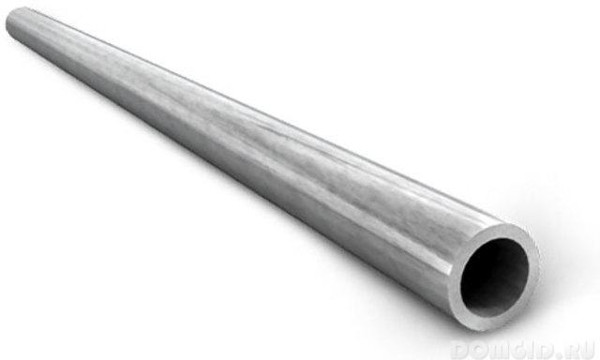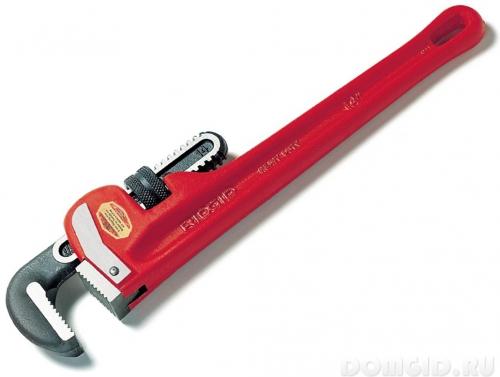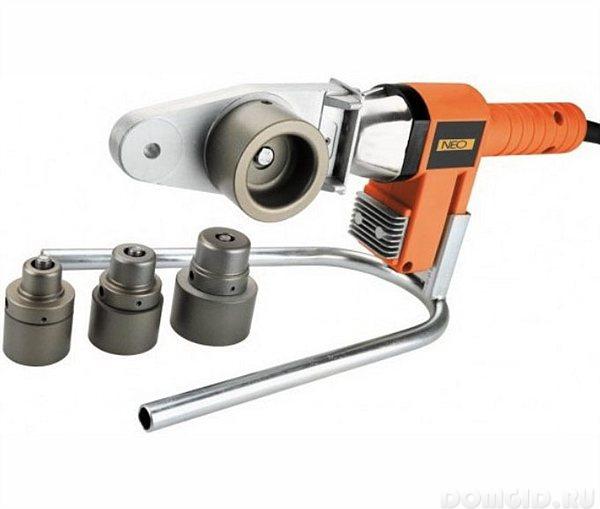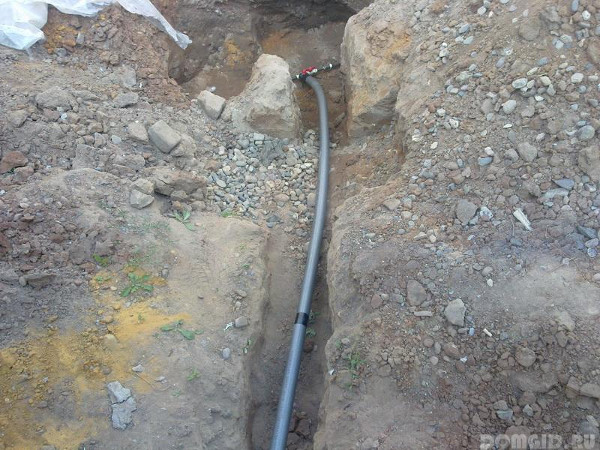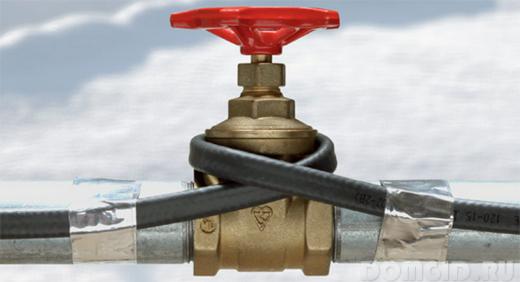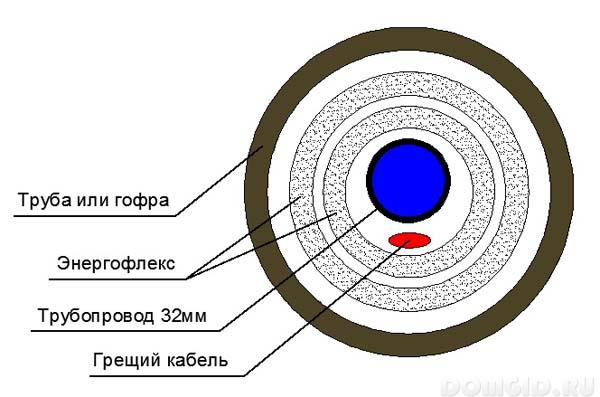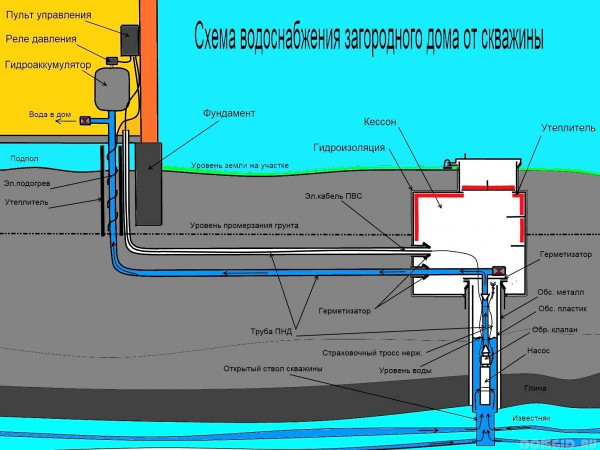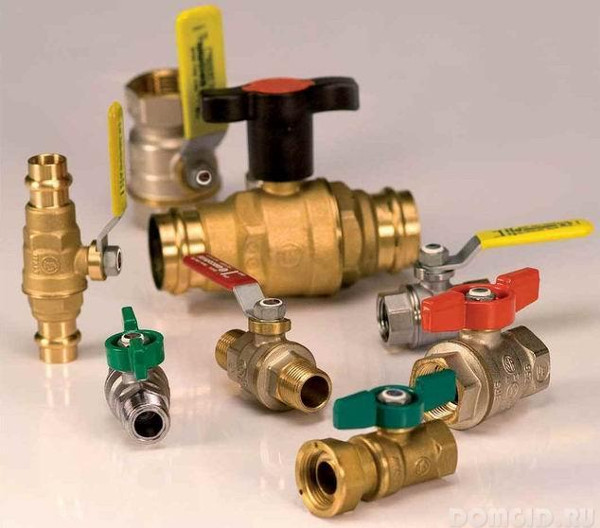Materials and tools for plumbing
- Metal-plastic pipes are the most economical solution to bring water into the house with your own hands;
Copper pipes are the most expensive, but resist corrosion better than steel pipes;
A steel pipeline in order to bring water into the house is more reliable than a metal-plastic one, but it requires supervision - pipes need to be painted once a year, after removing rust;

A polypropylene line is the most popular option, since water supply is brought into the house forever, and PP products can last more than 50 years without repair and maintenance.
From the tool you will need ordinary wrenches, a gas wrench, winding - tow or FUM tape, a pipe cutter (for cutting plastic pipes), soldering iron (for soldering PP products), welding machine (for welding steel products).
Scheme of autonomous water supply main elements of the system
Whatever the source of autonomous water supply for a private house, it is necessary to create a diagram indicating all the main elements of the system and the materials used to lay the water supply.
The water supply scheme of a private house includes the following elements.
- A well is a source of water.
- Caisson - an auxiliary room of the well (plastic or metal barrel). Protects the mouth from groundwater, precipitation and ensures a normal temperature in the well.
The plumbing system of a private house can be divided into three blocks:
- Water intake system.
- Courtyard highway.
- Domestic plumbing.
How to equip an autonomous water supply system
Before you bring water into the house from the well, you need to calculate its daily consumption. According to these data, we select pumping equipment, pipeline section and scheme.
Let's get acquainted with the step-by-step execution of work:
- we drill a well in the selected area;
- install a caisson or make it yourself from brick or concrete;
- we carry out the installation of a pumping station and filters (if necessary);
- laying a pipeline between the well and the house;
- we do internal wiring.
After the well is installed, we install and insulate the caisson. This structure must be protected with waterproofing materials from moisture.
In the case of a brick caisson, we make a foundation. The same operations are carried out in the manufacture of a concrete structure, the mixture is poured into a pre-arranged formwork of wooden panels.
A hermetic hatch is provided in the upper part of the caisson. To prevent debris and groundwater from entering the well, this element should rise 30-40 centimeters above the soil surface.
In most cases, pumping equipment, together with a hydraulic accumulator, is installed in a caisson. With this placement of the main mechanisms, the cost of transporting the liquid is reduced.
Many property owners place the pumping station in the pantry, under the stairs or in the cellar, the main thing here is to properly install the equipment and provide easy access to it.
Particular attention must be paid to the laying of pipelines. The lines must be in the soil below the depth of its freezing.
If this is not done, the pipelines will be exposed to negative temperatures and will quickly fail.
According to the developed scheme, we mark the site and dig a trench of the required depth, then lay the pipes.
For a water supply device, products made of metal-plastic or cross-linked polyethylene with a diameter of 32 mm are suitable.
To prevent freezing, the line is insulated with special materials. If soil conditions do not allow digging a trench of sufficient length, then a heating cable is laid next to the pipelines.
The heating element is turned on in the winter.A wire for connecting a pumping station can also be laid in trenches, its cross section should not be less than 2.5 mm2.
Internal wiring is carried out according to a previously developed scheme.
Here it is necessary to provide shut-off valves for emergency liquid shut-off, as well as additional tee elements for connecting users to the central line.
This video shows how to equip a well and enter a water pipe into a house:
Arrangement of the water intake system
well drilling and installation of a caisson
The process of drilling a well for water is the sampling of soil using a special drill. Depending on the type of well and its depth, drilling can be done independently, or you can use the services of drilling rigs. The method of drilling (impact, rotary) will depend on the type of soil.
❝The area around the location of the proposed well should not have any underground paths and buildings. To equip a well, it is necessary to allocate a plot with an area of 4 * 6 m 2 ❞
For manual drilling use:
Well drilling sequence:
- The tripod is installed above the well drilling site.
- To excavate the upper layers of the soil (1-1.5 m), it is necessary to use a pin drill.
- After passing the top layer, replace the pin drill with a casing pipe.
- Drilling continues until reaching the aquifer.
- After finding the desired layer, a galvanized water pipe with a filter at the end must be inserted inside the casing pipe.
The next step is the arrangement of the caisson. This room is necessary for protection against groundwater, freezing and for servicing the well. In the caisson, the outlet of the pipe from the well and the water supply leading to the house will be connected.
You can purchase a ready-made caisson body, or you can make it yourself from concrete rings or bricks.
❝The caisson must be installed so that its bottom and pipeline are below the level of soil freezing, and the roof of the hull rises above the surface - by 30 cm❞
The order of installation of the caisson:
- Dig the well pipe to a depth of about 2.5-3 meters. The diameter of the pit should be twice the size of the caisson.
- Pour a concrete cushion at the bottom (thickness 20 cm).
- Install the caisson.
- Cut the well pipe - it should protrude 50 cm inside the caisson.
selection of the optimal pump
To ensure the supply of water to consumers with the necessary pressure, it is necessary to install powerful equipment for lifting water. This may be an automated pumping station for the water supply of a private house or a submersible pump.
The pumping station includes:
- water pump;
- hydraulic accumulator;
- pressure switch.
❝The pumping station is suitable for servicing a shallow well (up to 10 m), if the distance from the water intake point to the end user is no more than 10 meters❞
An autonomous station can be used to equip a water supply system in a country house from a well, and to provide water to a cottage or a private house, it is better to install a deep-well pump - a borehole submersible rotary pump.
When choosing a submersible pump model, consider:
- pump head - the pressure force applied in order to push the water;
- flow rate (capacity) of the pump.
It is necessary to determine the required power of a submersible pump to service a particular well. Consider the example of a private 2-storey house for a family of 4 people. We summarize the following indicators:
- well depth (35 m);
- distance from the hydraulic accumulator to the outlet of the well in the ratio 1:10 (0.8);
- distance from ground level to the highest water intake point (about 3.5 m - for a 2-storey building);
- required pressure at the high point of water intake (3);
- possible losses in the system (about 2).
Thus: Pump head = 35+0.8+2+3+2=44.3 m
The family's peak water consumption of 38 l/min (2.28 m3/h) determines the performance of the pump.
submersible pump installation
It is necessary to lower the pump into the well very carefully so as not to damage the equipment. To do this, you can use a winch for drilling a well or cables.
Pump submersion sequence:
- Connect the check valve to the pump.
- Attach the compression sleeve and connect to the external pipeline.
- Pass the cable through the fixing eyes and fix it with metal clamps.
- Attach the power cable and pipe to the cable.
The next step after installing the pump is to bring the pipeline into the house and assemble an automatic water supply system.
The subtleties of the autonomous water supply device
The process of arranging the water supply system of a private house from a well can be divided into stages. Let's get acquainted with each of them in more detail.
Location selection
When installing a water supply system, it is necessary to choose the right place for the well. Previously, they were drilled near the kitchen or at home, and even arranged in the basement.
Such placement methods are good, but they have one significant disadvantage - the user will not be able to flush the well after it has been filled. If the well fails, a new one will have to be drilled, sometimes this is not possible.
It is best to choose a place for the well in close proximity to the house, but certain sanitary standards must be taken into account. The water intake point is placed no closer than 20 meters from the septic tank or sewage pit.
This requirement is true for sandy loam and loamy soils. On sandy soils, the distance is increased to 50 meters
Shallow wells, as well as the Abyssinian well, are located no closer than 5 meters to the foundation of the building.
During the pumping of water from loose soil, rock will be washed out. With the close proximity of the well to a residential building, after a while this will lead to subsidence and deformation of the base.
What to consider when developing a scheme, existing options
The construction of a water well in a private house begins with the development of a scheme.
Preliminary design allows you to divide the process into stages, to study all the nuances that may arise during the installation work. To improve the quality of water supplied to the consumer, it is necessary to install special filters.
When developing a scheme yourself, you must consider:
- the depth of the aquifer;
- soil composition;
- overall dimensions of the equipment for selecting the parameters of the caisson;
- liquid source characteristics;
- need for water;
- operating conditions.
Deep artesian wells are designed for 50 years. Water from such sources does not contain harmful impurities that could lead to premature failure of the pump and other equipment.
Video review of equipment for arranging water supply from a well:
The scheme is selected taking into account the daily fluid intake. During peak periods, users should be able to get water without problems. Next, we will get acquainted with the most common schemes.
Standard scheme
The classic option involves the use of a pumping station. In this case, the water supply of a country house depends on electricity.
With a significant need for liquid, such equipment wears out quickly, so the unit must be of high quality and powerful. In addition, you will have to allocate additional space for installing the device.
The classic water supply scheme from a well consists of the following elements:
- source of water supply;
- pumping station or deep unit of centrifugal type;
- metal or plastic caisson;
- non-return valve (the device prevents the backflow of liquid during the shutdown of the pump);
- filters for water purification;
- hydraulic accumulator;
- control system.
tower scheme
In this case, a deep pump is used, which pumps water into a special container in the attic.This allows you to meet the demand for liquid during peak hours, as well as during power outages.
With such a connection of water, it flows to consumers by gravity. A float is installed in the storage tank, which is responsible for the operation of the pump.
The switch operates according to the following principle:
- the unit turns off after filling the tank;
- as needed, residents consume water, which leads to a decrease in its level;
- when the float drops to a certain level, the pump turns on.
Such a scheme is considered the simplest and most reliable, the risk of water hammer is minimal.
There are some disadvantages here - the need for a certain usable space for installing the tank, unstable pressure in the system, additional loads on the supporting structures. In addition, the storage tank must be insulated.
Useful video, a diagram on paper of a water pipe from a well:
Types of wells
Before proceeding with the arrangement of the water supply system of a private house from a well, it is necessary to familiarize yourself with their main types.
To obtain liquid for own needs and household needs, drilling can be carried out at different depths.
In the first case, it is necessary to reach the aquifer from coarse sand. Depending on the characteristics of a particular area, such a layer lies at a depth of 15 to 40 meters.
The second option, wells "for limestone" are drilled to a depth of 200 meters. For this, a large diameter pipe is used. Such a well is characterized by high productivity, it can provide drinking water to the whole village.
The disadvantage of this method is the need for special equipment and the rise in the cost of work. Downhole pumps are used to supply water to consumers in wells "on sand" or "on limestone".
There is another type of well, which is called the Abyssinian well. In this case, a hole in the soil before reaching the aquifer is not drilled, but pierced. To do this, a sharp tip is provided in the lower working part of the pipe. There is also a perforated area covered with a mesh filter.
In order for this element to be securely held in place during a puncture, the diameter of the tip must slightly exceed the cross section of the pipe. The pipe structure performs several functions - casing and transporting fluid to consumers.
In such an autonomous water supply system, surface pumps are used. Such equipment can pump liquid at an aquifer depth of not more than 10 meters, with a pipeline cross section of 1.5 inches.
The main advantages of this type of wells include:
- Comparative ease of drilling in the absence of solid rock on the site.
- The engineering communication device is not only in a separate structure (caisson), but also in the basement.
- Low cost pump.
Despite significant advantages, the Abyssinian well has several minor drawbacks. This is a short period of operation, low productivity, as well as poor water quality in areas with poor ecology.
Watch an interesting video, what to choose - an Abyssinian well or a well:
Why do you need a caisson?
The caisson is a plastic container of certain overall dimensions, such an element can be made of concrete rings or bricks. The design protects the liquid in the upper part of the well from freezing in the winter season, prevents precipitation from getting on the pumping equipment and other elements and mechanisms.
Factory caissons are made not only of plastic, but also of metal. Such containers are completely sealed, often have a ladder and a lid. Product sizes vary.
The internal volume should be enough to install equipment and carry out repairs.
The purpose of the storage tank, where to place it
The most expensive element of an autonomous water supply system, in addition to the well itself, is a booster pump. The main mechanism in such a device is considered to be an electric motor, its constant starts and stops reduce the durability of the equipment.
The storage tank is used to reduce the number of pump operations. The reservoir accumulates a supply of liquid.
When the water level drops to the minimum required mark, the automation starts the pump. For this, a special mechanism is used that activates the pressure sensor. Installation of the storage tank is carried out at the level of the head of the well or in a heated attic.
In the first variant, the supply of liquid to consumers is carried out at the expense of a pumping station. This equipment turns on after opening the mixer, when the water pressure decreases. In such a system, pressure is always stable, but its operation will depend on electricity.
In the second case, water flows to consumers by gravity, but it will need to be pumped into the attic with a submersible pump. The pressure depends on the level of the liquid in the tank, it is usually low.
The video tells about the water supply of a private house with a storage tank:
How to bring water into the house from a well
A full-fledged and equipped according to all the rules plumbing to a private house is:
- Own well and surface (or deep) pump in it. In rare cases, they use a pumping station - the equipment is too expensive to serve a small family;
- Filter system: coarse filter in front of the pump, and fine filter at the end of the water pipe;
- A hydraulic accumulator is a storage tank that provides the necessary pressure in the drinking water supply system of the house;
- Water is supplied to the heating boiler and to the hot water boiler.
Surface pumps are too low-powered, and are able to lift water from a depth of ≤ 9 meters, so let's consider how to conduct water from a well to a house with a deep pump - such units also work at a depth of up to 200 meters.
The arrangement of the water supply system begins with the construction of a special recess - a caisson, which is designed to protect the well from melt water, and also serves as a heater. From this recess in winter it is convenient to inspect the well during the maintenance and repair of pumping or filtration equipment.
The walls of the caisson are laid out with bricks, but the best option is to lower a pair of reinforced concrete or thick-walled polymer rings into the pit. The bottom of the pit is covered with a sand cushion, crushed stone is poured on top, the layers are rammed. The bottom of the caisson should be located below the freezing point of the soil in the region, and from this level do-it-yourself pipe-laying into the house from the well begins.
The width of the caisson is no more than 1.5 x 1.5 meters, the walls are insulated with foam plastic (polystyrene foam) and plaster, which is applied to the PPU sheets. A layer of waterproofing is applied over the plaster layer - bitumen, tar or mastic. The hole is closed with a lid.
If the water from the well will be raised by a surface pump, it is installed right there, in the caisson. When the submersible pump is operating, it is lowered into the well, and from the caisson it is already possible to carry water from the well to the house by connecting the hose from the pump to the underground pipeline.
The technology of arranging the water supply system of a private house from a well
The commencement of work on the installation of a water supply system requires the developer to have the following information:
- required daily intake;
- the location of the well or well;
- entry point of the route into the building;
- number of plumbing fixtures.
Based on the obtained values, a plan for laying external networks is drawn and a wiring diagram for internal consumers is drawn up.
The sequence of arranging home plumbing:
- Prepare a place for a revision well and excavate for laying an external conduit.
- Install the caisson.
- Lay the pipeline to the foundation of the building.
- Get into the building.
How to conduct water from a well to a house arrangement of a source
Conducting water from the well to the house.
Work on arranging a water intake point begins with a breakdown of the site and subsequent digging of a foundation pit to organize a viewing well or caisson. A crushed stone-sand mixture is laid on the prepared base, rammed, formwork is installed and a concrete platform is poured for shelter. The dimensions of the plate for the tank should be 350-450 mm larger than the dimensions of the tank.
Then, depending on the material of the caisson, prefabricated elements are assembled or a finished structure is installed. Conduct insulation and insulation of the outer surfaces of the shelter.
Main line for the water supply system of a private house
Water supply from the mine to the house is carried out using traditional steel or plastic pipes Ø 32 mm. Laying of polymer profiles is recommended to be carried out on a sandy base. Separate sections are connected with special couplings or fittings.
Selection and installation of pumping equipment for water supply of a country house
The type of submersible pump or stationary pumping station is selected taking into account the following performance characteristics:
Installation of pumping equipment.
- Well depth.
- Dynamic and static levels.
- Working diameter.
- . The capacity of the purchased installation must be 10% lower than the calculated source volume.
- Distance from the filter to the highest point of consumption.
At the same time, one must not forget about the total daily water consumption, on the basis of which the power and type of the pumping unit are selected.
Installation sequence:
- Install a coarse filter on the casing pipe.
- The suction pipe of the pump is supplied with .
- A pumping station is mounted on a concrete platform using anchor bolts.
- Ground the device.
- Connect the mains and power supply.
- Water is poured into the working chamber of the mechanism.
- Start the station and check the tightness of the connections.
Installation of devices and additional equipment must be carried out in strict accordance with the manufacturer's instructions. If during assembly do-it-yourself questions arise regarding the correct installation of structural elements, you should immediately seek the advice of specialists, and not try to correct the errors yourself.
Yard highway conducting water supply from the well
tools and materials
For conducting water supply on the site, you can use different types of pipes:
- Copper pipes are the most expensive, but also the most reliable pipes. The material is not susceptible to corrosion, aggressive biological environment and ultraviolet radiation, has good heat transfer.
❝Diameter of the pipeline from the well should be 32mm❞
Piping tools:
- For installation of steel or copper plumbing:
- adjustable, gas and wrenches;
the sequence of laying and warming the water supply
The pipeline can be laid in two ways:
In the first case, a trench is dug at a depth of 2 meters and a pipeline is laid. The pipe in the lifting points must be insulated (especially near the foundation). This can be done with a self-regulating heating cable.
❝The foundation of the house to which the water supply is connected must be insulated at least to a depth of 1 meter❞
If the water supply is laid on top, then a heating cable (9 W / meter) must be connected to the pipe. In addition, the entire pipe is thoroughly insulated with heat-insulating material - a layer of insulation of at least 10 cm.
You can use energy flex and cotton wool. The joints between the heaters must be wrapped with reinforced tape - this will improve the sealing between the layers.
❝The pipe must be insulated along the entire length of the yard main: from the house to the well❞
The entire "pie" of the water supply is placed in a large corrugated or sewer pipe. Such measures will avoid freezing of the water supply and use the well in winter.
Together with the pipe, the supply cable for the pump can also be laid at the same time. It is better to use a 4-core cable with a cross section of 2.5.
After installing the pump and laying the water supply to the house, it is necessary to assemble an automatic water supply system according to the scheme.
Recommendations of specialists for the installation and configuration of the water supply system
Normal operation of household appliances and plumbing is possible with uninterrupted supply and sufficient water pressure. Here are some tips that will help you correctly assemble and configure the water supply system:
- It is better to equip water supply on the site in the warm season - the risk of making a mistake with the location of the aquifer is reduced, since the water level is the lowest during this period.
- If it is necessary to run the pipeline through interior partitions, walls or other building structures, the pipe must be enclosed in a plastic or metal cup.
Before starting operation, the system must be checked for leaks and performance.
https://youtube.com/watch?v=U6BUnSt4guM

Each owner of suburban real estate tries to create the most comfortable conditions in a private house. In the absence of a central water supply, the question arises of how to arrange water supply from a well.
From our article we will learn how to bring water to the house with our own hands.
